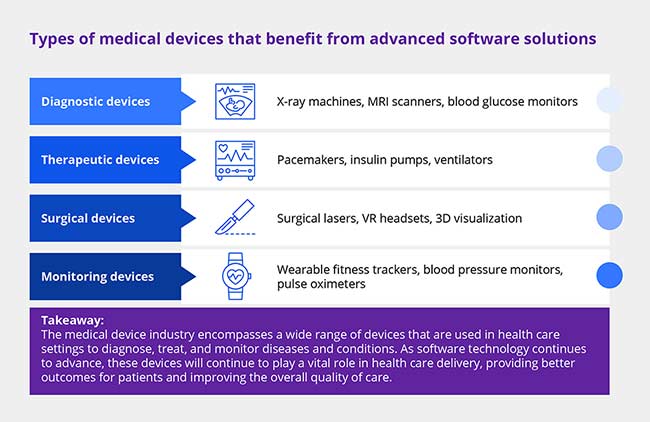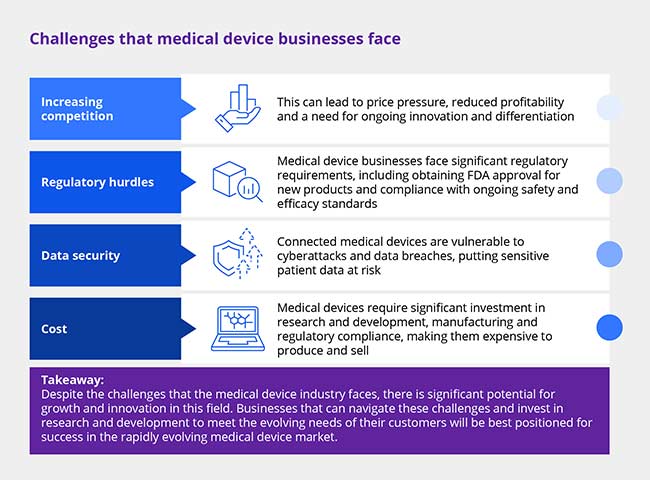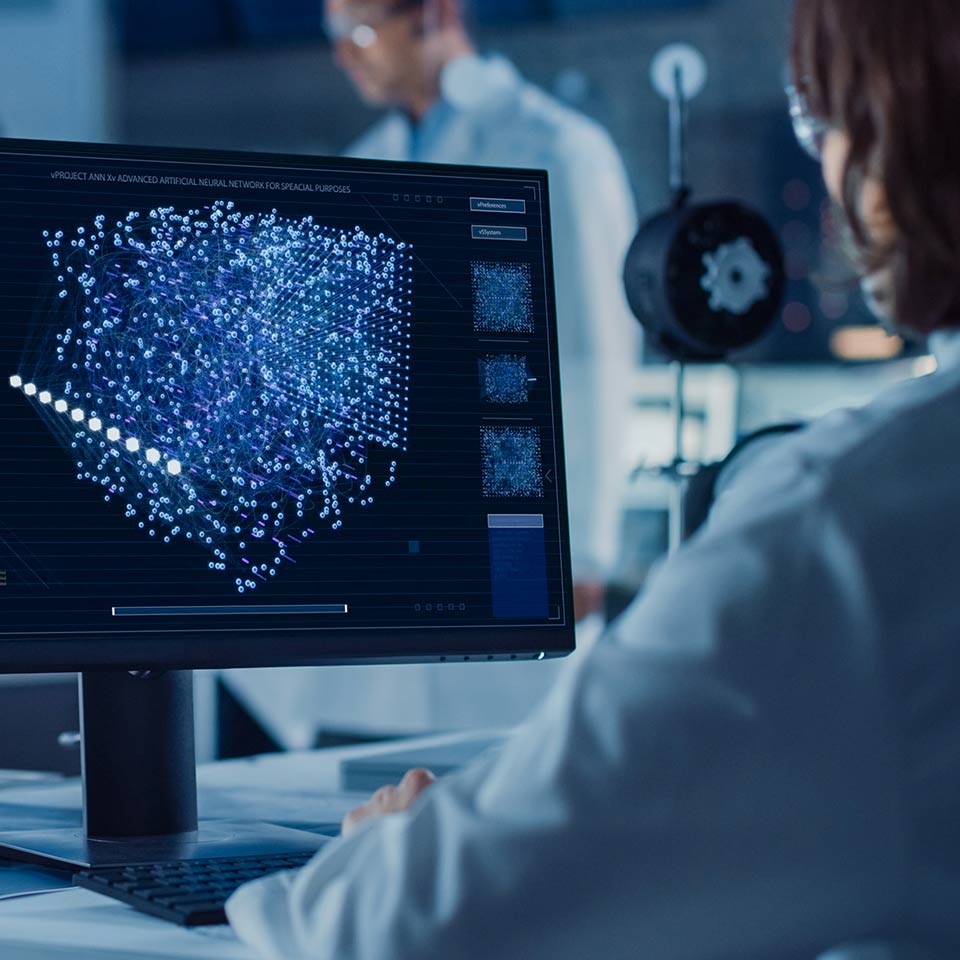In brief
- Medical devices are driving the digital transformation of health care by providing accurate diagnoses, effective treatments and personalized care through advanced algorithms and patient data analysis
- The medical device industry faces regulatory challenges with stringent requirements, evolving regulations, global harmonization, cybersecurity concerns and post-market surveillance
- Advancements in personalized medicine, implantable devices, smart medical devices, and non-invasive surgery offer better care, improved patient outcomes and reduced costs

Medical devices are crucial in the digital transformation of health care. They can help health care providers deliver accurate diagnoses, effective treatments, and personalized care to patients thanks to advanced algorithms that capture and analyze patient data. Moreover, innovations in medical devices can engage and empower patients to manage their health through wearable devices and telemedicine platforms. It’s fair to say that medical devices are essential in transforming health care by providing tools and technologies that improve patient outcomes, enhance clinical decision-making, and empower patients to take an active role in their own health.
With the support of healthcare software companies, medical device technology has advanced rapidly in recent years, significantly improving patient care and outcomes. Implantables and wearable medical device trends — as well as advancements such as telemedicine platforms, robotics and AI, 3D printing, nanotechnology, and augmented and virtual reality — are improving the precision, personalization, and effectiveness of patient care. There’s a lot of potential for these advancements to revolutionize health care.
Medical device providers themselves are at a crucial point. Digital transformation is critical to remain competitive and meet the evolving needs of health care providers and patients. By integrating digital technologies into their products, medical device businesses can create smarter and more connected devices that provide more accurate and personalized care. Ultimately, embracing digital transformation is essential for medical device businesses to succeed and grow in the industry. Let’s look at the latest trends in the medical device industry and the obstacles that they face.
Current business challenges in the medical device industry

The medical device industry provides a service to health care that grows in importance each year. But even as the market grows, certain challenges remain.
Regulatory challenges
Regulators want to ensure that medical devices are safe, effective, and meet the needs of patients and health care providers. Some of the key regulatory challenges facing the medical device industry include:
- Stringent regulations: Regulatory agencies such as the FDA and EMA require extensive testing and clinical data before approval for use
- Evolving regulatory landscape: The regulatory landscape for medical devices is constantly evolving, with new regulations and standards introduced in response to emerging technologies and changing health care needs
- Global harmonization: Medical device companies must navigate regulatory requirements in different countries and regions, with varying approval processes and timelines
- Cybersecurity: Medical devices are vulnerable to cyberattacks as they become increasingly connected to networks and other devices. Regulatory agencies require companies to demonstrate that their devices are secure and can protect patient data
- Post-market surveillance: Regulators require medical device companies to monitor the safety and effectiveness of devices once on the market, report any adverse events or quality issues, and take appropriate action
This puts pressure on medical device companies to stay up to date by investing heavily in research, development, and post-market surveillance to ensure their devices meet the needs of patients and health care providers while maintaining regulatory compliance.
Increased competition
An increasingly crowded market is a challenge for medical device businesses as it can lead to price pressure and reduced profitability. It also speeds up the product lifecycle, putting pressure on R&D teams to innovate and iterate more quickly.
Medical device companies may need to lower prices to remain competitive — impacting their profitability — and market saturation can make it challenging for them to grow their business.
Pricing pressure
We've already mentioned the pricing pressure of competition, but this pressure has a much farther reach than the bottom line. Medical devices often require significant investment in research and development, manufacturing, and regulatory compliance, which can be expensive. Pricing pressures can limit the ability of companies to invest in these areas, potentially leading to a lack of innovation and slower product development. Moreover, if pricing pressures result in reduced profit margins, businesses may need to cut costs in other areas, which can impact the quality of products or services provided to customers.
Data security
The increasing connectivity of medical devices and the sensitive nature of the data they collect present significant security challenges. Medical devices allow for real-time monitoring and data collection, which benefits patient experiences. However, the data collected by medical devices often include sensitive information such as patient health records, making them an attractive target for cybercriminals. Even further, networking these devices means a breach isn't contained to just one device but spread across an entire network of devices. Medical device businesses can face severe legal consequences for failing to protect patient data, not to mention the financial repercussions.
High-value use cases for improved care

Despite these challenges, the future of medical devices is bright, and numerous advancements on the horizon will offer patients better care that is more efficient and will support health care providers in diagnosis, treatment and monitoring. Some of these medical device technology trends include:
Personalized medicine
AI and machine learning-enabled devices can provide personalized treatment plans tailored to individual patients by analyzing a patient's specific health data and medical history. Personalized medicine is also vital for underrepresented groups because it can help address health disparities within these populations.
For example, women may experience different symptoms or side effects from medications than men, and minorities may be at a higher risk for certain diseases. Personalized medicine can account for these differences and provide targeted treatments that are more effective for these groups.
Implantable devices
Medical devices implanted into the body can monitor and treat chronic conditions in real time. For example, Senseonics' Eversense E3 System can continuously monitor glucose levels in diabetic patients. In the future, these implants may also be able to automatically adjust medications, such as altering insulin dosages to maintain healthy blood sugar levels. By removing complexity, health care providers can improve outcomes in both short and long-term care.
Smart medical devices
Medical devices connected to the internet can provide real-time data to health care providers, improving patient outcomes and reducing costs. These devices can collect and transmit patient data, allowing health care providers to monitor patients remotely and provide timely interventions when necessary. For example, the Apple Watch can monitor vital signs and track physical activity, providing real-time data to health care providers.
Non-invasive surgery
Medical devices that leverage robotics and AI can perform surgeries without the need for invasive procedures, reducing recovery times and costs. Robotic-assisted surgery can also provide greater precision and accuracy, minimizing the risk of complications.
One example is the da Vinci Surgical System, used in urologic, gynecologic, cardiac, and general surgery procedures. The system consists of a surgeon console, patient-side cart, and vision cart, which work together to provide a minimally invasive surgical experience. Another example is the Rosa Spine robotic surgical assistant, used in spinal surgeries. The system combines 3D modeling and navigation capabilities with robotic assistance, allowing surgeons to perform complex spinal procedures with increased accuracy and efficiency.
Medical devices are shaping the future of health care
The medical device industry is rapidly advancing, with significant technological advancements on the horizon that have the potential to revolutionize health care delivery. Despite challenges like regulatory hurdles and concerns over data security, the benefits of medical device technology are significant, with the potential to improve patient outcomes, reduce health care costs and address health disparities. As the industry continues to evolve, medical device businesses must continue to invest in research and development, adapt to changing market conditions, and prioritize patient safety and data security to ensure continued success.







